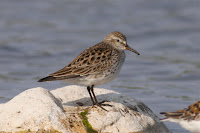WHITE-RUMPED SANDPIPER
WHITE-RUMPED SANDPIPER – (Calidris fuscicollis) – (See images below)
DESCRIPTION: The White-rumped Sandpiperhas white under parts and medium mottled brown upper parts. The bill and legs are also brown. Plumage varies with the seasons and age (adult vs juvenile) but not with the sexes. It is a small shorebird measuring around 20 cm long (7.8 inches).
VOICE: https://www.xeno-canto.org/species/Calidris-fuscicollis
NAME: The English name ‘Sandpiper’ stems from ‘sand’, and Latin ‘pipa’, which means to ‘chirp’. The Latin genus name ‘Calidris’ is from ancient Greek and refers to a greyish shorebird. The Latin species name ‘fuscicollis’ means ‘dark neck’.
HABITAT:Tundra in the summer, wetland shores in the winter.
DIET: Insects and other invertebrates.
NESTING: Shallow depression on the ground in a sheltered location. Usually four green eggs are laid, which are incubated by the female. She tends for the chicks, but these are able to feed themselves.
DISTRIBUTION: The breedng range is in the Arctic. Its migration covers the eastern half of North America and most of South America except the Andes region. Some individuals have been able to reach Hawaii. (See note below on bird vagrancy.)
Distribution map: https://en.wikipedia.org/wiki/White-rumped_sandpiper#/media/File:Calidris_fuscicollis_map.svg
ON PEI: The white-rumped sandpiper does not breed on Prince Edward Island, but is fairly to very common in the fall during its migration.
CONSERVATION: Climate change has started to impact the migration of this species. However it is currently not considered at risk.
NOTES: As with other species in this family, the bill of the white-rumped sandpiper is equipped with corpuscles of Herbst at the tip, which allow the bird an increased sensitivity in finding its prey – small invertebrates for the most part – in mud and sand.
There have been hybrids of this species with the Dunlin.
Vagrancy: In biology this means an animal going way outside its normal range. For birds, this can happen when there are storms and they get blown off course. On other times, the bird simply wanders in a different direction than usual. Here’s an article about vagrancy in birds.
SIMILAR SPECIES: Dunlin, Least Sandpiper, Semipalmated Sandpiper
REFERENCES: https://www.borealbirds.org/bird/white-rumped-sandpiper
https://www.audubon.org/field-guide/bird/white-rumped-sandpiper
https://en.wikipedia.org/wiki/White-rumped_sandpiper
https://www.allaboutbirds.org/guide/White-rumped_Sandpiper/id
https://identify.whatbird.com/obj/421/_/White-rumped_Sandpiper.aspx
DESCRIPTION: The White-rumped Sandpiperhas white under parts and medium mottled brown upper parts. The bill and legs are also brown. Plumage varies with the seasons and age (adult vs juvenile) but not with the sexes. It is a small shorebird measuring around 20 cm long (7.8 inches).
VOICE: https://www.xeno-canto.org/species/Calidris-fuscicollis
NAME: The English name ‘Sandpiper’ stems from ‘sand’, and Latin ‘pipa’, which means to ‘chirp’. The Latin genus name ‘Calidris’ is from ancient Greek and refers to a greyish shorebird. The Latin species name ‘fuscicollis’ means ‘dark neck’.
HABITAT:Tundra in the summer, wetland shores in the winter.
DIET: Insects and other invertebrates.
NESTING: Shallow depression on the ground in a sheltered location. Usually four green eggs are laid, which are incubated by the female. She tends for the chicks, but these are able to feed themselves.
DISTRIBUTION: The breedng range is in the Arctic. Its migration covers the eastern half of North America and most of South America except the Andes region. Some individuals have been able to reach Hawaii. (See note below on bird vagrancy.)
Distribution map: https://en.wikipedia.org/wiki/White-rumped_sandpiper#/media/File:Calidris_fuscicollis_map.svg
ON PEI: The white-rumped sandpiper does not breed on Prince Edward Island, but is fairly to very common in the fall during its migration.
CONSERVATION: Climate change has started to impact the migration of this species. However it is currently not considered at risk.
NOTES: As with other species in this family, the bill of the white-rumped sandpiper is equipped with corpuscles of Herbst at the tip, which allow the bird an increased sensitivity in finding its prey – small invertebrates for the most part – in mud and sand.
There have been hybrids of this species with the Dunlin.
Vagrancy: In biology this means an animal going way outside its normal range. For birds, this can happen when there are storms and they get blown off course. On other times, the bird simply wanders in a different direction than usual. Here’s an article about vagrancy in birds.
SIMILAR SPECIES: Dunlin, Least Sandpiper, Semipalmated Sandpiper
REFERENCES: https://www.borealbirds.org/bird/white-rumped-sandpiper
https://www.audubon.org/field-guide/bird/white-rumped-sandpiper
https://en.wikipedia.org/wiki/White-rumped_sandpiper
https://www.allaboutbirds.org/guide/White-rumped_Sandpiper/id
https://identify.whatbird.com/obj/421/_/White-rumped_Sandpiper.aspx
 |
| White-rumped sandpiper, Silver Leapers |
 |
| White-rumped sandpiper, by Dfaulder |
 |
| This White-rumped sandpiper says 'hello', photo by Silver Leapers |